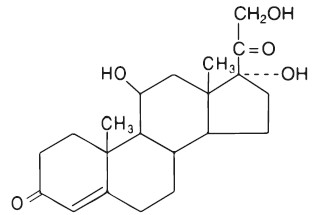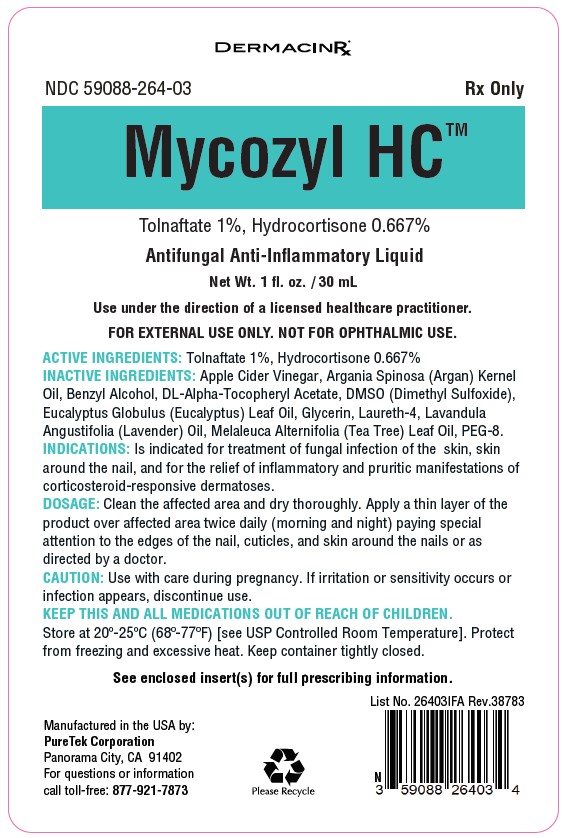Mycozyl HC Prescribing Information
Package insert / product label
Generic name: tolnaftate, hydrocortisone
Dosage form: topical liquid
Medically reviewed by Drugs.com. Last updated on Dec 14, 2023.
On This Page
Mycozyl HC Description
Each gram of Mycozyl HC™ contains 6.67 mg of hydrocortisone and 10 mg of tolnaftate in a vehicle consisting of: Apple Cider Vinegar, Argania Spinosa (Argan) Kernel Oil, Benzyl Alcohol, DL-Alpha-Tocopheryl Acetate, DMSO (Dimethyl Sulfoxide), Eucalyptus Globulus (Eucalyptus) Leaf Oil, Glycerin, Laureth-4, Lavandula Angustifolia (Lavender) Oil, Melaleuca Alternifolia (Tea Tree) Leaf Oil, PEG-8.
Chemically, hydrocortisone is [Pregn-4-ene-3,20-dione, 11,17,21-trihydroxy-, (11ß)-], with the molecular formula C21H30O5 and molecular weight 362.47 and is represented by the following structural formula:

Chemically, tolnaftate molecular formula is C19H17NOS and molecular weight 314.5 and is represented by the
following structure formula:

Mycozyl HC - Clinical Pharmacology
Topical corticosteroids share anti-inflammatory, anti-pruritic and vasoconstrictive actions. The mechanism of anti-inflammatory activity of the topical corticosteroids is unclear. Various laboratory methods, including vasoconstrictor assays, are used to compare and predict potencies and/or clinical efficacies of the topical corticosteroids. There is some evidence to suggest that a recognizable correlation exists between vasoconstrictor potency and therapeutic efficacy in man. Tolnaftate has antifungal properties.
Pharmacokinetics:
The extent of percutaneous absorption of topical corticosteroids is determined by many factors including the vehicle, the integrity of the epidermal barrier, and the use of occlusive dressings. Topical corticosteroids can be absorbed from normal intact skin. Inflammation and/or other disease processes in the skin increase percutaneous absorption. Occlusive dressings substantially increases the percutaneous absorption of topical corticosteroids. Thus, occlusive dressings may be a valuable therapeutic adjunct for treatment of resistant dermatoses. (See DOSAGE AND ADMINISTRATION). Once absorbed through the skin, topical corticosteroids are handled through pharmacokinetic pathways similar to systemically administered corticosteroids. Corticosteroids are bound to plasma proteins in varying degrees. Corticosteroids are metabolized primarily in the liver and then are excreted by the kidneys. Some of the topical corticosteroids and their metabolites are also excreted by the bile.
Indications and Usage for Mycozyl HC
Mycozyl HC™ is indicated for treatment of fungal infection of the skin, skin around the nail, and for the relief of inflammatory and pruritic manifestations of corticosteroid-responsive dermatoses.
Contraindications
This product is contraindicated in those patients with a history of hypersensitivity to any of the components of the preparation.
Precautions
Not for ophthalmic use. Keep out of reach of children. If swallowed, get medical help or contact a Poison Control Center right away. Avoid contact with eyes, lips and mucous membranes.
General:
General: Systemic absorption of topical corticosteroids has produced reversible hypothalamic-pituitary-adrenal (HPA) axis suppression, manifestations of Cushing's syndrome, hyperglycemia, and glucosuria in some patients. Conditions which augment systemic absorption include the application of the more potent steroids, use over large surface areas, prolonged use, and the addition of occlusive dressings. Therefore, patients receiving a large dose of a potent topical steroid applied to a large surface area or under an occlusive dressing should be evaluated periodically for evidence of HPA axis suppression by using the urinary free cortisol and ACTH stimulation tests. If HPA axis suppression is noted, an attempt should be made to withdraw the drug, to reduce the frequency of application, or to substitute a less potent steroid. Recovery of HPA axis function is generally prompt and complete upon discontinuation of the drug. Infrequently, signs and symptoms of steroid withdrawal may occur, requiring supplemental systemic corticosteroids. Children may absorb proportional y larger amounts of topical corticosteroids and thus be more susceptible to systemic toxicity (See PRECAUTIONS-Pediatric Use). If irritation develops, topical corticosteroids should be discontinued and appropriate therapy instituted. In the presence of dermatological infections, the use of an appropriate antifungal or antibacterial agent should be instituted. If a favorable response does not occur promptly, the corticosteroid should be discontinued until the infection has been adequately controlled.
Information for the Patient: Patients using topical corticosteroids should receive the following information and instructions:
1. This medication is to be used as directed by the physician. It is for external use only. Avoid contact with the eyes.
2. Patients should be advised not to use this medication for any disorder other than for which it was prescribed.
3. The treated skin area should not be bandaged or otherwise covered or wrapped as to be occlusive unless directed by the physician.
4. Patients should report any signs of local adverse reactions especially under occlusive dressing.
5. Parents of pediatric patients should be advised not to use tight-fitting diapers or plastic pants on a child being treated in the diaper area, as these garments may constitute occlusive dressings.
Laboratory Tests: The following tests may be helpful in evaluating the HPA axis suppression: Urinary free cortisol test; ACTH stimulation test.
Carcinogenesis, Mutagenesis, and Impairment of Fertility:
Long-term animal studies have not been performed to evaluate the carcinogenic potential or the effect on fertility of Tolnaftate.
Pregnancy:
Teratogenic effects -
Pregnancy Category C. Corticosteroids are generally teratogenic in laboratory animals when administered systemically at relatively low dosage levels. The more potent corticosteroids have been shown to be teratogenic after dermal application in laboratory animals. There are no adequate and well -controlled studies in pregnant women on teratogenic effects from topically applied corticosteroids.
Therefore, topical corticosteroids should be used during pregnancy only if the potential benefit justifies the potential risk to the fetus. Drugs of this class should not be used extensively on pregnant patients, in large amounts, or for prolonged periods of time.
Nursing Mothers:
It is not known whether topical administration of corticosteroids could result in sufficient systemic absorption to produce detectable quantities in breast milk. Systemically administered corticosteroids are secreted into breast milk in quantities not likely to have a deleterious effect on the infant. Nevertheless, caution should be exercised when topical corticosteroids are administered to a nursing woman.
Pediatric Use:
Pediatric patients may demonstrate greater susceptibility to topical corticosteroid-induced HPA axis suppression and Cushing's syndrome than mature patients because of a larger skin surface area to body weight ratio. Hypothalamic- pituitary-adrenal (HPA) axis suppression, Cushing's syndrome, and intracranial hypertension have been reported in children receiving topical corticosteroids. Manifestations of adrenal suppression in children include linear growth retardation, delayed weight gain, low plasma cortisol levels, and absence of response to ACTH stimulation. Manifestations of intracranial hypertension include bulging fontanelles, headaches, and bilateral papilledema. Administration of topical corticosteroids to children should be limited to the least amount compatible with an effective therapeutic regimen.
Chronic corticosteroid therapy may interfere with the growth and development of children.
Adverse Reactions/Side Effects
The following local adverse reactions are reported infrequently with topical corticosteroids, but may occur more frequently with the use of occlusive dressings. These reactions are listed in an approximate decreasing order of occurrence: burning, itching, irritation, dryness, folliculitis, hypertrichosis, acneiform eruptions, hypopigmentation, perioral dermatitis, allergic contact dermatitis, maceration of the skin, secondary infection, skin atrophy, striae and miliaria.
Overdosage
Topically applied corticosteroids can be absorbed in sufficient amounts to produce systemic effects (See PRECAUTIONS).
Mycozyl HC Dosage and Administration
Clean the affected area and dry thoroughly. Apply a thin layer of the product over affected area twice daily (morning and night) paying special attention to the edges of the nail, cuticles, and skin around the nails or as directed by a doctor.
How is Mycozyl HC supplied
Mycozyl HC™ is supplied in a 1 fl. oz. / 30 mL glass bottle with a screw cap fitted with a brush applicator ( NDC 59088-264-03)
Store at 20º-25ºC (68º-77ºF) [see USP Controlled Room Temperature]. Protect from freezing and excessive heat. Keep container tightly closed.
Use under the direction of a licensed healthcare practitioner.
Call your doctor about side effects. To report side effects, call
PureTek Corporation at
1-877-921-7873 or FDA at 1-800-FDA-1088 or
www.fda.gov/medwatch.
Manufactured by:
PureTek Corporation
Panorama City, CA 91402
For questions or information
call toll-free:
877-921-7873
| MYCOZYL HC
tolnaftate, hydrocortisone liquid |
||||||||||||||||||||||||||
|
||||||||||||||||||||||||||
|
||||||||||||||||||||||||||
|
||||||||||||||||||||||||||
|
||||||||||||||||||||||||||
|
||||||||||||||||||||||||||
| Labeler - PURETEK CORPORATION (785961046) |

